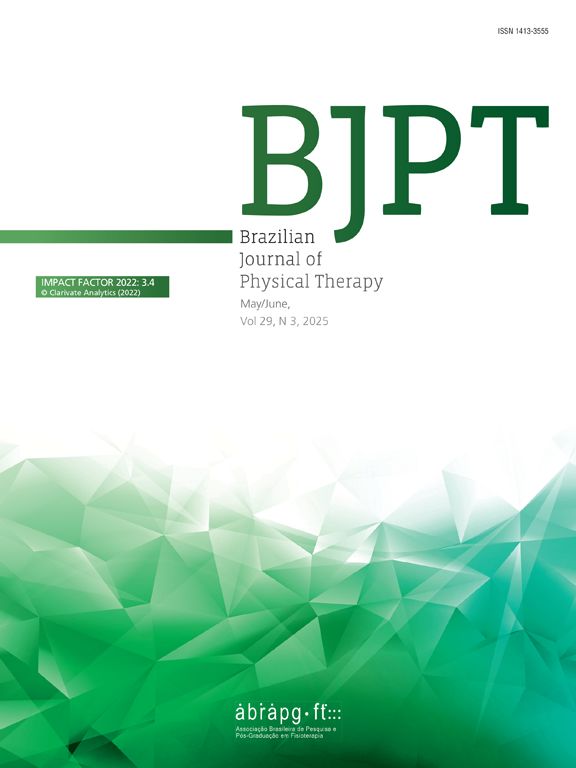
1st STUDENT SCIENTIFIC CONFERENCE OF THE BRAZILIAN ASSOCIATION FOR RESEARCH AND POSTGRADUATE IN PHYSIOTHERAPY (ABRAPG-FT)
More infoKnee osteoarthritis is one of the main causes of disability in the elderly. Most of this population has movement restrictions and functional limitations (morning stiffness, reduced joint mobility, crackles and muscle atrophy) that compromise the performance of daily activities. Therefore, investigating aspects of the functionality of patients with knee osteoarthritis is relevant.
ObjectivesThis study aimed to compare the functional performance among participants with a neuropathic-like symptoms and central sensitization related signs and symptoms, and their knee osteoarthritis counterparts.
MethodsA cross-sectional observational study was conducted with 125 participants with knee osteoarthritis (94 females, mean age 63.1±7.4 years). Participants completed a self-reported questionnaire with personal and clinical features and musculoskeletal pain characteristics, including neuropathic-like symptoms (PainDETECT questionnaire), central sensitization related signs and symptoms (Central Sensitization Inventory, CSI), and conditioned pain modulation (Cold Pressor Test). Self-reported functional disability (Western Ontario and McMaster Universities Osteoarthritis Index, WOMAC) and functional mobility (Timed Up and Go, TUG) were compared among patients with neuropathic-like symptoms, central sensitization related signs and symptoms and their knee osteoarthritis counterparts using the one-way analysis of variance (ANOVA).
ResultsThirty-three (26.4%) participants had neuropathic-like symptoms and central sensitization related signs and symptoms, eighteen (14.4%) had neuropathic-like symptoms, twenty-seven (21.6%) participants had central sensitization related signs and symptoms, and 47 (37.6%) had knee osteoarthritis with no neuropathic-like symptoms or central sensitization related signs and symptoms. A one-way ANOVA revealed greater functional limitation in the group with neuropathic-like symptoms and central sensitization related signs and symptoms (mean = 67.5±12.0) or neuropathic-like symptoms (mean = 56.7±17.5) than the group without these symptoms (mean = 32.0±20.7) with a statistical significance difference [F(3, 121) = 29.434, p < 0.001] in the WOMAC total score. The group with neuropathic-like symptoms and central sensitization related signs and symptoms (mean = 19.2±7.4) or neuropathic-like symptoms (mean = 16.3±6.3) had slower velocity than the group without these symptoms (mean = 11.6±3.5) with a statistical significance difference [F(3,121) = 10.045, p < 0.001] in the TUG test.
ConclusionParticipants with knee osteoarthritis and neuropathic-like symptoms or central sensitization pain phenotype have greater functional limitations than their counterparts.
ImplicationsIdentifying distinct pain phenotypes in patients with knee osteoarthritis is endorsed to treat these patients adequately. The phenotype with neuropathic plus central pain component share similarities with patients with neuropathic-like symptoms, except for the conditioned pain modulation. Measuring the factors that affect the functionality in patients waiting for knee replacement may contribute to assertive decision-making. In this sense, the presence of neuropathic-like symptoms or central sensitization leads to a unfavored clinical outcomes in patients with knee osteoarthritis.
Conflict of interest: The authors declare no conflict of interest.
Acknowledgment: This study was financed in part by the Fundação Carlos Chagas Filho de Amparo à Pesquisa do Estado do Rio de Janeiro (FAPERJ) [Grant number: E-26/211.104/2021] and Coordenação de Aperfeiçoamento de Pessoal de Nível Superior - Brasil (CAPES) [Finance Code 001; Grant number: 88881.708719/2022-01, grant number: 88887.708718/2022-00, and grant number 88887.466981/2019-00].
Ethics committee approval: This study was approved by the Research Ethics Committee of Augusto Motta University Center (UNISUAM) (number 48067621.0.0000.5235) and of Jamil Haddad National Institute of Traumatology and Orthopaedics (INTO) (number 48067621.0.3001.5273) in accordance with the Helsinki Declaration for research in humans.




